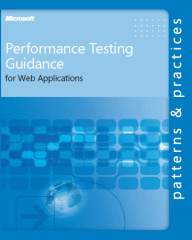Some time back, I blogged about a book I’d been significantly contributing to being available as a free .pdf download. (see the entry here)
Well, the book quietly appeared in “dead tree format” (as Stuart Moncrieff put it in his blog post about the book)
a couple of weeks ago and I’ve been getting light heartedly scolded by
some of my friends and readers for not making a big announcement, so
here’s my “big announcement.”
by: J.D. Meier, Scott Barber, Carlos Farre, Prashant Bansode, and Dennis Rea is now available on Amazon.
Reviewed by: Alberto Savoia, Ben Simo, Cem Kaner, Chris Loosley, Corey Goldberg, Dawn Haynes, Derek Mead, Karen N. Johnson, Mike Bonar, Pradeep Soundararajan,
Richard Leeke, Roland Stens, Ross Collard, Steven Woody, Alan
Ridlehoover, Clint Huffman, Edmund Wong, Ken Perilman, Larry Brader,
Mark Tomlinson, Paul Williams, Pete Coupland, and Rico Mariani.
The best part is that you can
buy the book on Amazon, download the PDF, browse the HTML, or do any combination of the above.
Even though this as a Microsoft patterns&practices book, it is a
tool, technology, & process agnostic book (which, along with the
content of the book being available for free, and me not losing IP
rights to any of the content I contributed, were the commitments MS made
to me before I agreed to contribute). What that means is that the book
should apply equally well to a LoadRunner/Eclipse/Agile project it
applies to a VSTS/.NET/CMMI project.
What that also means is that if you’re looking for a “cookbook” or a
“how-to” manual, this isn’t it. This is a book that focuses on core
principles that deliberate and successful performance test projects seem
to have in common and topics the authors and reviews agreed (or at
least mostly agreed) were common enough to be worthy of your
consideration. Not everything in this book will apply to everyone – in
fact, I’d be shocked and concerned to learn that everything in this book
applied to ANY one person or project.
Even though I wrote the initial draft of all but 3 of the 18 chapters
in the book and was the last set of eyes on the manuscript to be
focused almost entirely on the content, there are parts of the book that
I love and parts that I’m already ready to re-write. That said, one of
my goals for this book is to give the authors, trainers, bloggers,
researchers, and doers a common point of reference to debate over and
grow from (even if ALL of the growth ends up being counter to the
guidance in the book!) Many of the authors and reviewers of this book
have enough individual knowledge and experience to write one or more
performance testing books on their own (as do many folks who aren’t
authors or reviewers of this book), but none of the ones I talked to
wanted to write the first tool, technology & process neutral,
project life-cycle book for practitioners about testing the performance
of software systems. We all knew it was an impossible undertaking as
there is simply no way to cram an encyclopedia’s worth of information
into one easy to digest book. And none of us wanted to be the one to
fail at it.
I don’t think this book fails at it – though it comes far from
succeeding. The book represents a consensus from a very wide range of
individuals, schools of thought, experiences, and backgrounds. It is
filled with the stuff we seem to be able to agree on. Some people call
those agreements “Best Practices”. I call them “reasonable places to
start”, which is what I hope this book becomes; a reasonable place for
all of the performance testers with knowledge and experience to share to
use as a starting point to tell their own stories and share their own
experiences.
To tell the truth, that is exactly what I’ve done with my new Performance Testing Courses, that I’ll write more about next time. I built my
experiences, personality, preferences, and probably some of my biases,
into a collection of workshops that (IMHO) extends and compliments the
book. I hope others do the same… whether they do so through blogs,
articles, training, or through applying concepts from the book with a
healthy dose of individuality, doesn’t much matter to me. What matters
to me is that this book serves to remove the barrier of not wanting to
write “the book that cannot be written” so that we can get more quality
information into the world for performance testers to read, reference,
use, debate, extend and explore. If that happens, I’ll count the book
as a great success.
Happy reading. I hope you find the book valuable.
--
Scott Barber
Chief Technologist, PerfTestPlus, Inc.
About.me
Co-Author, Performance Testing Guidance for Web Applications
Author, Web Load Testing for Dummies
Contributing Author, Beautiful Testing, and How To Reduce the Cost of Testing
"If you can see it in your mind...
you will find it in your life."

No comments:
Post a Comment